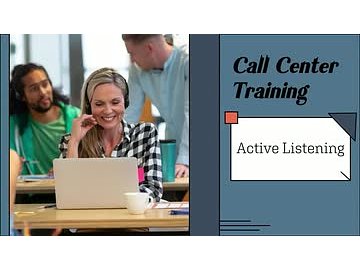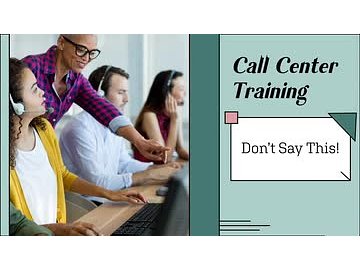Call Center Training: Duties of the Customer Service Representative
A customer service rep takes calls from customers. That's not hard to figure out. But there's so much more to this role than you might realize, if you've never worked in a call center. In this course, we'll go over the various responsibilities to this essential role. Whether you're called a customer service agent or associate, your duties might include solving customer problems, answering questions, offering technical support, documenting issues and requests, meeting call quotas, and most importantly, being a positive representative for your company.
Call Center Training: Skills of the Customer Service Representative
In our last course, we talked about what to do as a call center representative. Here, we'll discuss HOW you'll accomplish those things. In other words, the skills you'll need to excel at your job. We'll cover the knowledge you should have in order to do your job well. We'll talk about the importance of paying attention to details, taking thorough notes, and developing emotional intelligence. We'll also discuss getting creative, staying organized, and being flexible.
Call Center Training: Phone Etiquette
What's the first thing you need to know when working as a call center representative? How to communicate well on the telephone! In this course, we'll talk about things like what to say as a greeting, how to remain polite, and using proper vocal tone and volume. We'll cover some helpful tips on being a better call-taker and how to politely place people on hold.
Call Center Training: Active Listening
Getting to the root of a customer's issue requires listening, of course. As a successful call center representative, there's a lot that goes into listening well. In this course, we'll discuss what it means to be an active listener and how that skill should be applied to your job. We'll go over some active listening tips and techniques, including ways to show that you're listening, avoiding assumptions, taking notes, and confirming that you understand.
Call Center Training: Asking Good Questions
As a call center representative, you'll learn quickly that every call and every caller are unique. A solution may work for some, but not for others. New problems and complaints arise all the time and you must learn to quickly and effectively troubleshoot these issues. You might even be required to sell or upsell. To do any of this well, you have to ask the right questions. You need to get to the root of the customer's issues to find a resolution, or you need to determine the customer's unmet needs in order to sell them a product that will meet those needs. In this course, we'll go over how to ask good questions. We'll discuss basic troubleshooting and how to use the TED approach in your questioning. We'll talk about more advanced troubleshooting techniques and how the funnel questioning method works. We'll also go over questions you can ask to find more sales opportunities.
Call Center Training: Don't Say This!
When you're working in a call center, there are a lot of things you need to remember to say. This might include your greeting, good questions to ask, your company script, etc. Have you ever thought about what you shouldn't say? Believe it or not, there are ten phrases that you should never say when you're on a call with a customer, and that's what we're going to cover in this course.
Call Center Training: Troubleshooting
As a call center representative, one of your main duties will be to solve people's problems with your company's products or services. To do this, you need to learn how to troubleshoot a customer's issue to find the root cause and figure out the best solution. In this program, we'll talk about how to become a better troubleshooter. We'll go over how to get to the root cause of a customer's issue, how to evaluate the situation, what you should do to find a possible solution, and how to carry out that solution.
Call Center Training: Handling Angry Callers
Dealing with angry customers is a brutal, yet unavoidable, part of your job as a call center representative. As you grow more experienced, you'll find that there are helpful techniques that will allow you to handle these customers with ease. That's what we'll be covering in this program. We'll discuss listening, apologizing, and taking responsibility on behalf of the company. We'll talk about how to deal with customers who are really upset and swearing. We'll also go over some things you want to avoid when talking to an angry customer.
Call Center Training: Escalating Issues
When you're handling customer issues, you always want to be able to solve it yourself. This is what's known as First Call Resolution, or FCR, and it's what every call center hopes will happen. But sometimes there are problems that are too complex, customers who are too demanding, or issues that are outside your scope. In those cases, you may need to escalate the issue. In this program, we'll talk about what that means. We'll go over some common reasons to escalate a call, and we'll also cover how it should be done.
Telephone Techniques: Greetings
Have you ever called a business only to be met with a bad greeting? Perhaps it was muffled and unintelligible? Or they simply didn't give you enough information in the greeting? Or maybe you've encountered someone who was curt, and almost rude, like you were burdening them with your call? These are all examples of bad telephone practices, and they can turn away customers. The greeting is your first impression, and it's important to get it right! That's what we'll cover in this course. We'll go over the four components to a great, professional greeting.
Customer Service for Field Service Technicians
As a field service technician, why should you care about customer service? Because whether you realize it or not, you're in the customer service business. It might not be the thing you were technically trained to do, and it might not be what you signed up for, but it's arguably as much a part of your job as the technical work. Without satisfied and returning customers, you wouldn't have a job at all. So, no matter how good you are at your work, your job depends on your ability to make and keep a happy customer. In this course, we'll talk about what the customers' expectations are, and how you can meet and exceed those when you're on service calls.
When the Customer Isn't Right: Retail Conflict for Managers
"The customer is always right." If you have any experience working in retail, you know this statement isn't accurate, nor is it a reasonable approach to customer service. There will always be unhappy or dissatisfied customers, and, unfortunately, conflict is inevitable. Because your employees are on the front line of customer conflict, they need to feel empowered to handle these situations. For that, they need to be armed with helpful de-escalation techniques and to know that you are on their side. In this course, we'll discuss how to empower your employees, so they're equipped to handle customer conflicts. We'll also go over your role in handling conflicts.
Creating Great Customer Conversations
Meaningful and effective interactions are the cornerstone of customer service. This course covers the four essential parts of excellent customer conversations: greet, inquire, act, and thank. By mastering these steps, you'll enhance customer satisfaction and build stronger relationships, increasing loyalty, trust, and ultimately profit.
Customer Service Later (Stop Exceeding Expectations)
When it comes to customer service, you want to satisfy customer needs so that they keep coming back. But how many times have you heard "Go the extra mile" or "Underpromise and overdeliver"? If you go beyond meeting customer needs, the customer is extra happy, and that's a good thing, right? The short answer is no. Setting the bar too high can hurt you in the end. In this course, we want to talk about why that's the case. We want to help retrain your customer service brain to simply satisfy, not exceed expectations, so your customers are happy, but don't expect more than they should.
The Four P's of Creating Loyal Customers
Good customer service is about more than just being friendly. That's not to say that friendliness isn't good or important, but creating loyal customers is more about answering this key question: how do we provide service that's good enough to turn ordinary customers into loyal promoters of our organization? To create more loyal customers, we need the four P's of creating customer loyalty, a series of principles designed to cultivate trust and repeat purchases among your customers. In this course, we'll take an in-depth look at the 4 Ps: products and services, process, perform, and people.
Often, millions of dollars are spent creating and maintaining a brand's image so that consumers will feel good about, and buy, their products. As a representative of a brand, you can do your part by looking good and acting appropriately every day. When you wear a company uniform, a nametag, or follow a dress code, you ARE the brand. In this course, we'll talk about how to present yourself to properly represent the brand you work for. We'll discuss appearance, driving company vehicles, language, attitude and more.
The customer service chat function can be effective and efficient, when handled properly. However, if the customer service chat representative isn't familiar with, or able to access, the information they need, it's frustrating for both parties. In this course, we'll help to ensure your chat service is helpful and proficient. We'll discuss the four basic skills needed for a successful online chat experience: soft skills, writing skills, platform skills, and product knowledge.
We've all been on the receiving end of bad customer service, but have you ever thought about the ripple effect one bad experience can create? You stop using that particular product or service, or use it less frequently, which means a loss in revenue for that business. Then you mention your lousy experience to someone else, or post about it on social media, which means even more revenue lost for that business. When you work for an organization of any kind, you know that customer satisfaction is paramount to a successful business. Therefore, customer service training is a must. That's what this course is all about. We'll discuss setting and meeting customer expectations and understanding customer needs.
Service Quality Indicators
It can be difficult to know what makes customers happy or how to provide good customer service. The question is, how can we take that ambiguity and measure it, so we know we're doing a good job? The answer is service quality indicators, or SQIs. To identify your organization's SQIs, you start by talking to your customers. In this course, we'll help you determine your company's SQIs, discuss strategies for gaining customer feedback, and provide tips for measuring and tracking your success.
Helping Customers Decrease Expenses
One of the best ways to partner with your customers is to help them decrease their expenses. Do your customers see you as a tool to help them lower their costs? How do you get them to see you that way and not as just another salesperson? In this course, we'll explore that as part of learning how to provide excellent customer service. We'll cover understanding customer expenses and then discuss potential ways to reduce their costs of goods, address their labor costs, and manage their occupancy costs.
Telephone Techniques: Taking Calls
Taking a phone call at work might seem simple. After all, you probably take phone calls in your daily life and muddle through just fine, right? But, these days, people don't actually make as many calls as they used to, with texting and video chatting in the mix. Or maybe you just have phone phobia when it comes to a professional setting. No matter what your situation is, there are some tips that can help you to be a better call-taker at work. That's what we'll cover in this course. We'll go over how to speak courteously, and we'll discuss what not to say. We'll also touch on staying informed on your business and how to actively listen.
Telephone Techniques: Hold, Please
No one likes being put on hold. But sometimes, it's an inevitable part of handling the phones. Maybe someone walks physically into your office. Maybe you need to get further information. Whatever the reason, sometimes when you're running the phones for a business, you have to put people on hold. So how do you avoid angering them when you do? In this course, we'll learn some techniques that research says makes it easier for the caller when they're placed on hold.
Telephone Techniques: Taking Messages
If answering the phone is a part of your daily duties, then you take a lot of messages. You're positioned as the gatekeeper of the company, and key to your company's operation. Your job is to limit solicitors, keep information private, and provide excellent customer service. In this course, we'll discuss exactly how to do this. We'll go over creating a plan with your boss and colleagues for certain instances, cover developing a callback schedule, and discuss the information that you'll want to collect from callers that require a callback.
Telephone Techniques: Angry Callers
Dealing with angry callers can be a burdensome part of your job. While these situations may be difficult, or even unpleasant, for you, they're also great opportunities to change these unhappy callers into satisfied customers. Yes, this really can happen. Here, you'll gain some tips to help you turn the unhappy into happy! We'll discuss the importance of listening, sincerity, and taking responsibility. We'll also go over finding solutions and fully resolving their issues.
Telephone Techniques: Phone Etiquette
Have you ever called a business, and it was literally impossible to connect with a human being? You went through prompt after prompt, hit the pound key a dozen times, and never talked to a person? Or even worse, the voice-automated prompts, that apparently don't detect human voices! You'll go hoarse screaming, "Speak to a REP-RE-SEN-TA-TIVE!" In this course, we'll help you keep your customers happy, by going over business phone etiquette. We'll discuss setting up, maintaining, and updating your business phone system. We'll also touch on basic phone etiquette for your workplace.
Customer Service Feedback: Feedback Basics
If you've purchased a product or service recently, there's a good chance you read customer reviews before doing so This is one of the most common forms of customer feedback today and it's one of the reasons experts refer to today's digital world as the "feedback economy." Customer feedback does, indeed, make the economic world go round. In this course, we're going to go over the basics - including the types of feedback, common ways of quantifying feedback, and why it's so important. In the rest of this series, you can explore a variety of ways to GET customer feedback.
Customer Service Feedback: Feedback Surveys
If you watched our first course on the basics of feedback, you learned about different types of feedback you might get from customers. In this course, we're going to shift gears to talk about how you can collect that feedback. There are, of course, a variety of ways, but we're going to focus on surveys here. We'll cover the different types of surveys, ways to measure and interpret results, and using incentives for participation.
Customer Service Feedback: Social Media Feedback
According to Social Media Today, 74% of consumers rely on social media to help them make buying decisions. If the post they read comes from a friend, colleague, or family member, it's even more impactful. More than 80% of the Social Media Today survey respondents said recommendations from family or friends strongly correlate to their buying decisions. So clearly, what people post about your company, products, and services online for their "friends" to see really matters. In this program, we'll talk through some of the ways you can use this avenue to gather customer feedback.
Customer Service Feedback: What To Do With Feedback
Once you've gathered your feedback, what do you do with it? That's what this course is all about. In this course, we'll discuss the three main steps: tracking, analyzing, and taking action. We'll go over various tracking methods, discuss the importance of objective analysis, and talk about when and how to make changes based on customer feedback.































